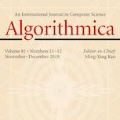A graph $A$ is "apex" if $A-z$ is planar for some vertex $z\in V(A)$. Eppstein [Algorithmica, 2000] showed that for a minor-closed class $\mathcal{G}$, the graphs in $\mathcal{G}$ with bounded radius have bounded treewidth if and only if some apex graph is not in $\mathcal{G}$. In particular, for every apex graph $A$ and integer $r$, there is a minimum integer $g(A,r)$ such that every $A$-minor-free graph with radius $r$ has treewidth at most $g(A,r)$. We show that if $t=|V(A)|$ then $g(A,r)\in O^\ast(r^9t^{18})$ which is the first upper bound on $g(A,r)$ with polynomial dependence on both $r$ and $t$. More precisely, we show that every $A$-minor-free graph with radius $r$ has no $16rt^2 \times 16rt^2$ grid minor, which implies the first result via the Polynomial Grid Minor Theorem. A key example of an apex graph is the complete bipartite graph $K_{3,t}$, since $K_{3,t}$-minor-free graphs include and generalise graphs embeddable in any fixed surface. In this case, we prove that every $K_{3,t}$-minor-free graph with radius $r$ has no $4r(1+\sqrt{t})\times 4r(1+\sqrt{t})$ grid minor, which is tight up to a constant factor.
翻译:暂无翻译



